In recent months we have had the opportunity to try wingsurfing more than once, and we have done it both as self-taught and by attending a wing surf course during our trip to Lanzarote in December, where our friend Alessandro from Lanzarotekite has now specialized in teaching of this new sport.
We therefore decided to share our experience, together with everything we learned about wingsurfing, including some little secrets and advice to help the new wingsurfer to progress faster, choose the right equipment, and evaluate whether to attend a course or try alone to try the wing. But let's go in order.
There are now hundreds of videos on wingsurfing on the web. Despite this, it is still not a widespread sport. The first time we had a wing sail in our hands was at the WindFestival last fall. Unfortunately there the conditions were not ideal: really too little wind to seriously understand something about the wing.
Our first serious approach to wingsurfing was therefore in Lanzarote, where our friend Alessandro from Lanzarotekite had already thrown himself body and soul to discover the limits and possibilities of this new toy ...
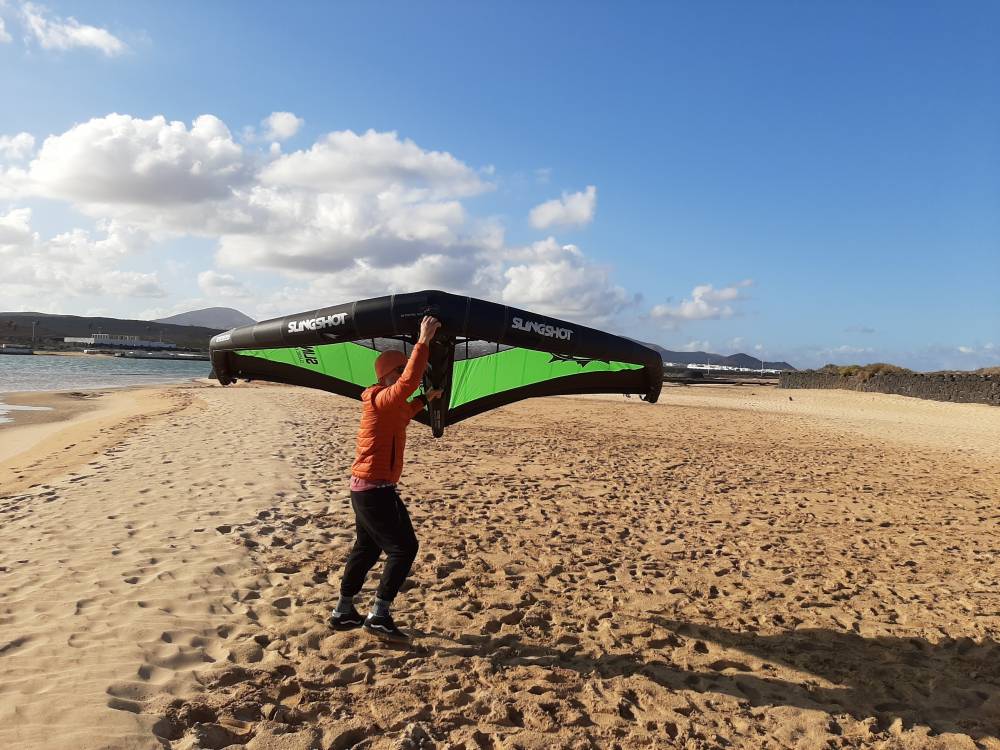
We did two wingsurfing course afternoons, about 4 hours in all. We have chosen for our lessons the moments when the wind was a bit too weak to have fun with kitesurfing and as a spot not Famara beach, where in those days the waves were decidedly demanding, but a sort of artificial lake in the nearby town of Santa, a stone's throw from the famous surf spot ... and here's how our first wingsurfing course went!
The Wing Surfing Course # Lesson 1
On the first day Sergio and I arrived handsome, confident that it would be child's play. After all we do kitesurfing, surfing, skate, sup ... in short, how difficult could this wingsurfing in a lake with flat water be? And then everyone kept saying that it's super easy, an accessible sport, for everyone. Together with us there were a couple of guys, none of whom also kitesurfing, but a windsurfer and a surfer.
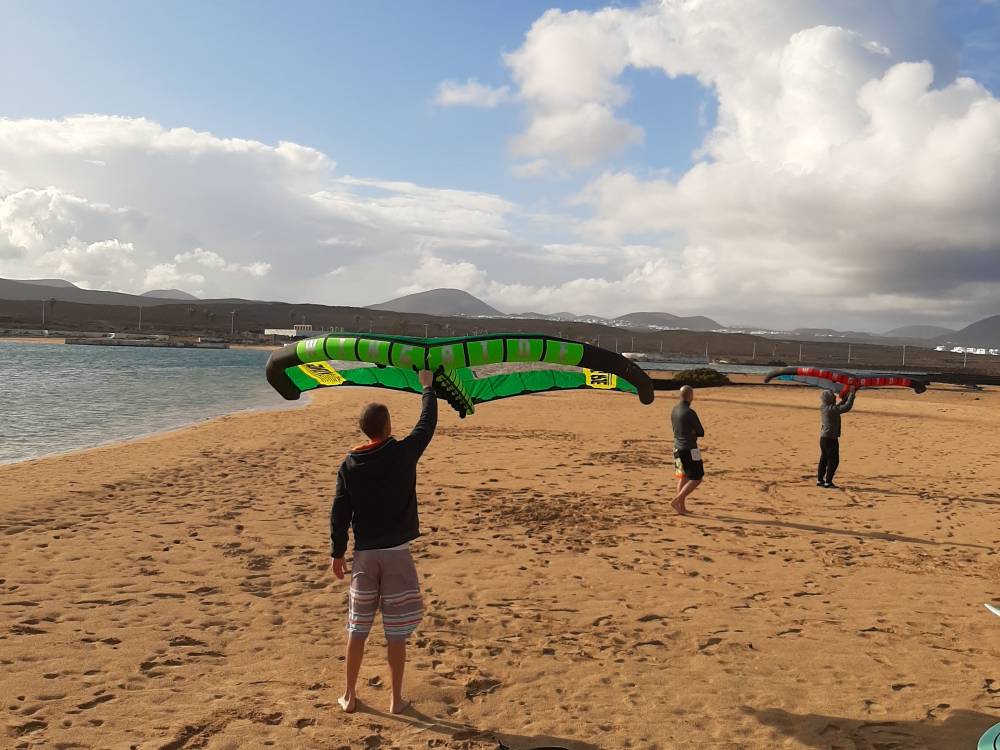
We inflate our wing and prepare to put on the wetsuits to get into the water immediately, impatient, but Alessandro stops us.
"Let's do some ground practice first . "
Okay, yes, it actually seems sensible.
We spend the next 10 minutes standing, on the ground, with our wings in our hands trying to familiarize ourselves with the traction of the wing, to identify the flight window and to understand how to move the wing in the wind.
The next step is to learn to turn the wingsurfing wing. This is a very important step, because in case of a fall in the water the wing tends to get belly up in the air and without the right technique turning it can be a small business!
On one knee, one hand holds the wing, putting it in the wind and raising it as much as possible, the other makes it turn.
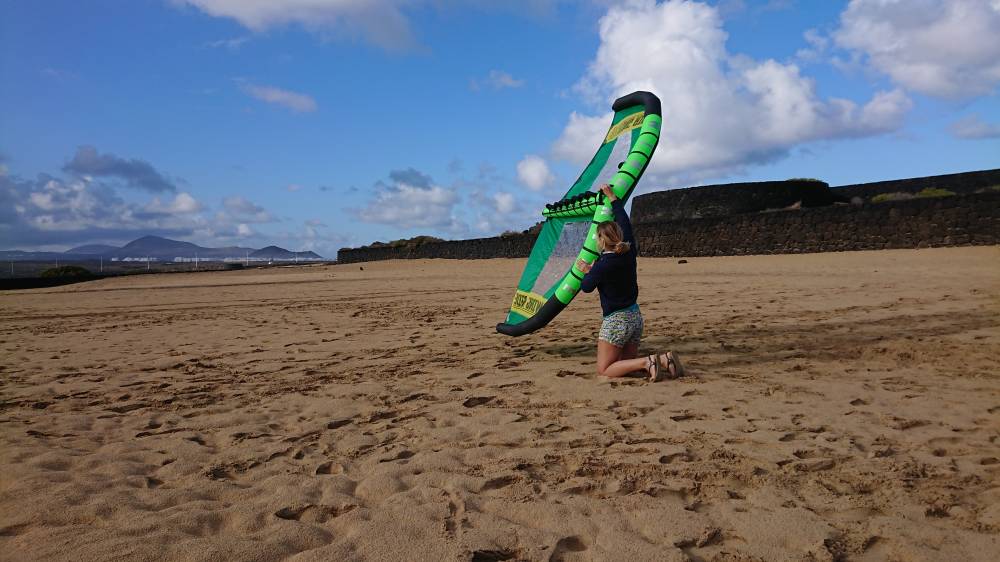
So far everything EASY.
While doing these exercises on the ground I couldn't help thinking about my kitesurfing course, done nearby (in Fuerteventura) several years ago. I remember very well how hard I worked to understand how to control that kite, which at the time only had two cables, and moved like a mad mosquito, banging everywhere.
After yes and no 15 minutes it was already time to get into the water!
For the first edges Alessandro gave us a Stand Up Paddle board, without foil and with a nice volume.
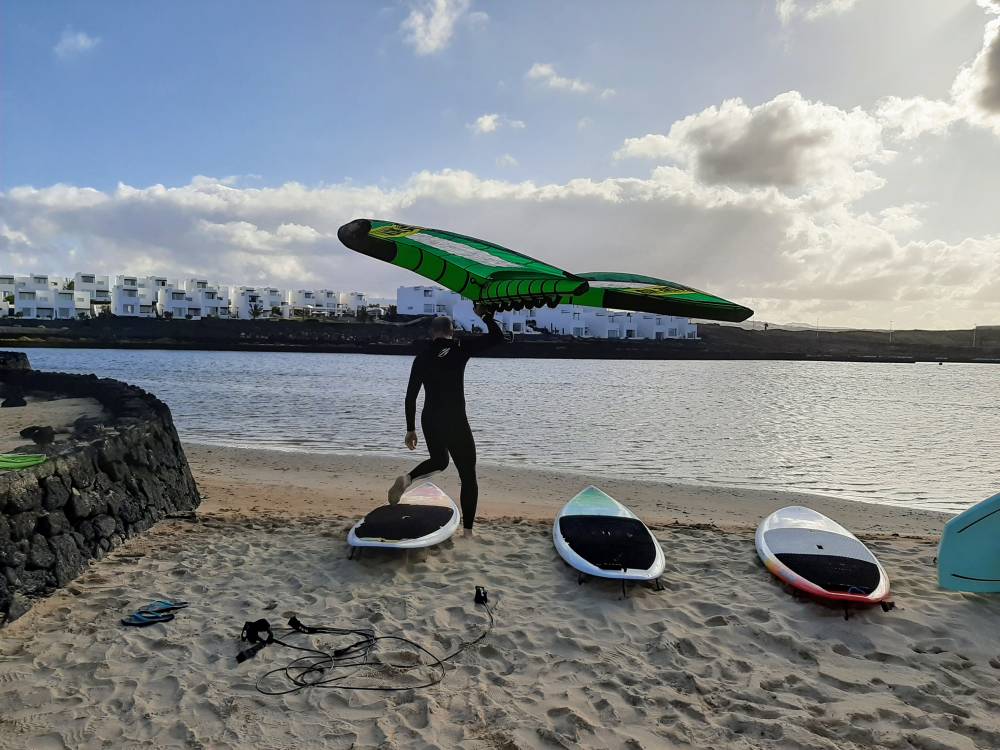
Tentatino n1. Holding the sail with one hand and the board under my arm I head into the water. I get on my knees, sail into position and ... on. It was actually not difficult.
But I barely have time to think that it is really as easy as they say I realize that in reality I am not going in the right direction at all. I am not going upwind at all, but full speed. I try to angle the sail, but nothing, I keep losing water. So I decided to go back to the shore and try again, thinking to myself that I got a little carried away, but on the second attempt I would have certainly managed to wind up.
Change board and point towards the beach.
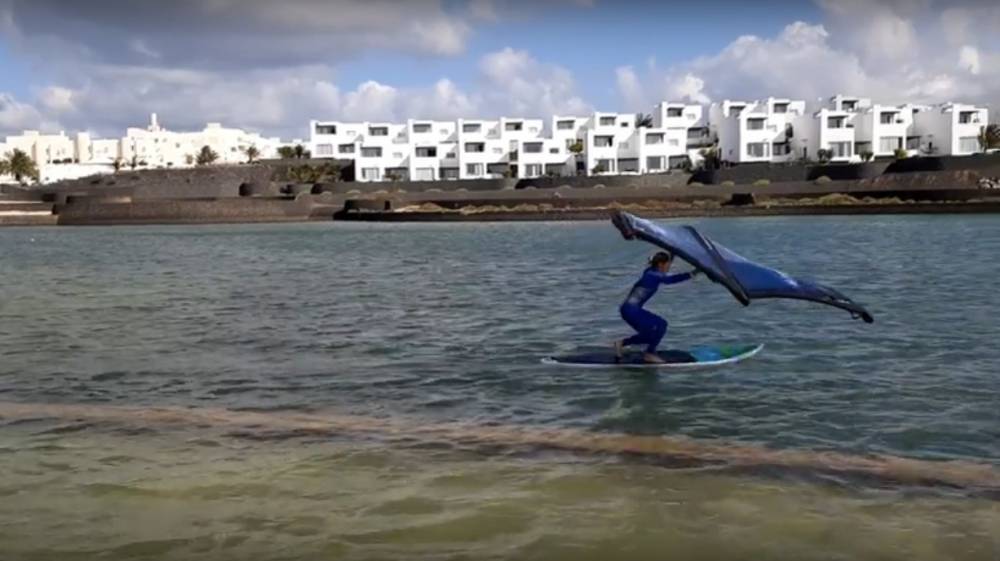
Considering that it is the first attempt, I am definitely satisfied. I managed to get up and even change the edge without falling. Great I think to myself. On the other hand, once on the shore, I realize that, unlike what I thought, I didn't just lose a little water, but I got really carried downwind. Returning to the starting point with a sup board under the arm and the wingsurfing wing in the other hand is not easy and it reminded me of the many, many walks made when I learned to wind with the kite, only that walking with a sup under the arm is much more uncomfortable than with a twintip.
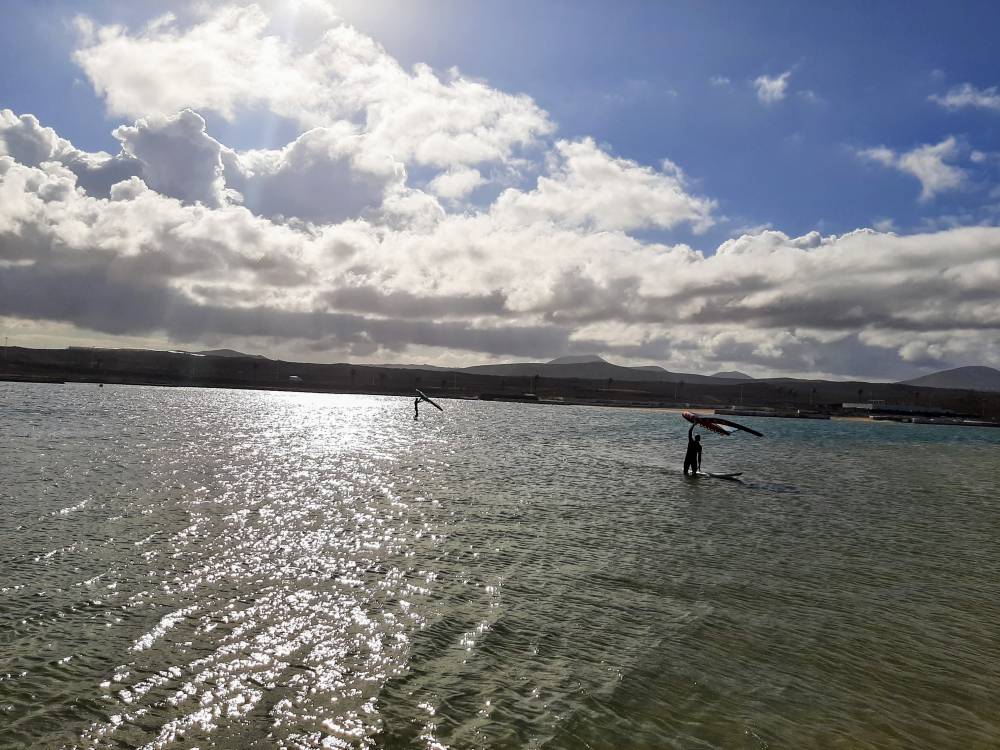
Tentatino n2. I go back into the water thinking about the position to keep so as not to be dragged loose, but in an attempt to tighten as much as possible keeping the sail at the edge of the window the wing tip touches the water and ... I fall. The time to get back on my knees on the board, turn the wing, get back in position and I realize that I ended up even more downwind than before. Again I walk back to the starting point.
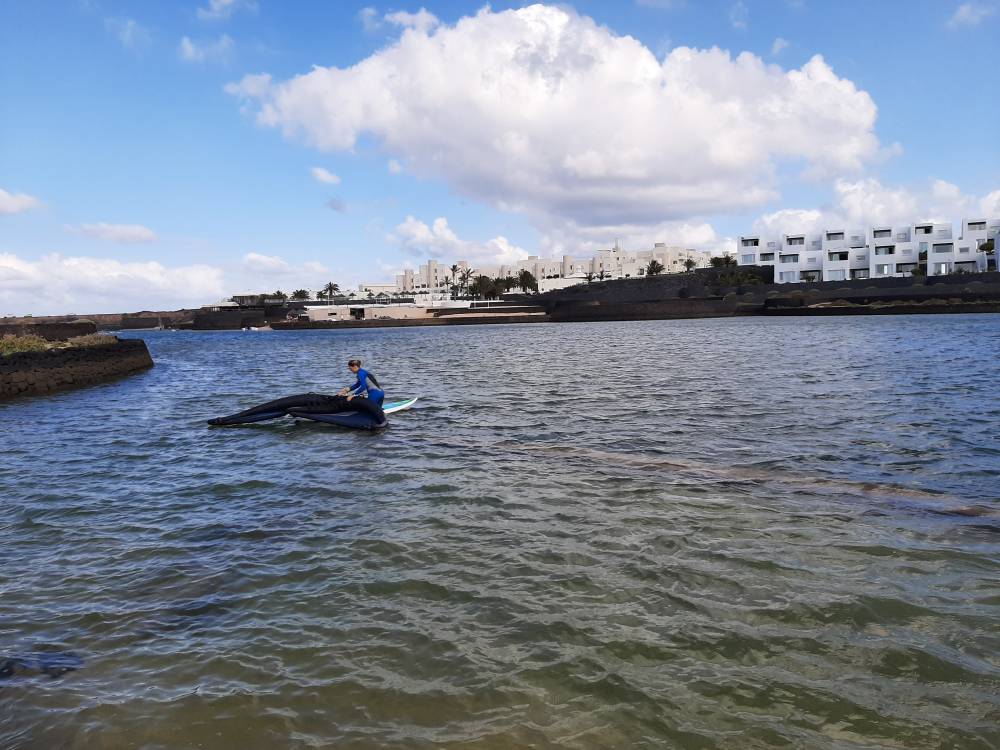
Attempt # 3 - Attempt # ...? I spend the next hour making one attempt after another, always trying to get back to the starting point, but nothing. I can't boil. For one reason or another, I always end up in the wind. Above all, I lose water when I leave and when I change the edge, water that I still can't recover enough. Not to mention the fact that as soon as I get distracted for a moment the arms are lowered, the tip touches the water and both me and the wing end up in the water.
Not that others have gone much better, except for the windsurfer. He actually seems to already have better control of the sail and already manages to make upwind stretches.
The wind has gone too far to continue. We fold up the equipment and go home.
The Wing Surfing Course # Lesson 2
On the second afternoon the wind seems slightly better, less gusty and a little more tense, and this time Alessandro entrusts us with sup with the foil. Today there are other students, so Sergio and I take turns in the water, but I must admit that I do not mind at all, because even if it is not a fatigue comparable to that of the first outings with surfing, it is not bad to rest your arms and shoulders sometimes. After a brief summary on land I enter the water.
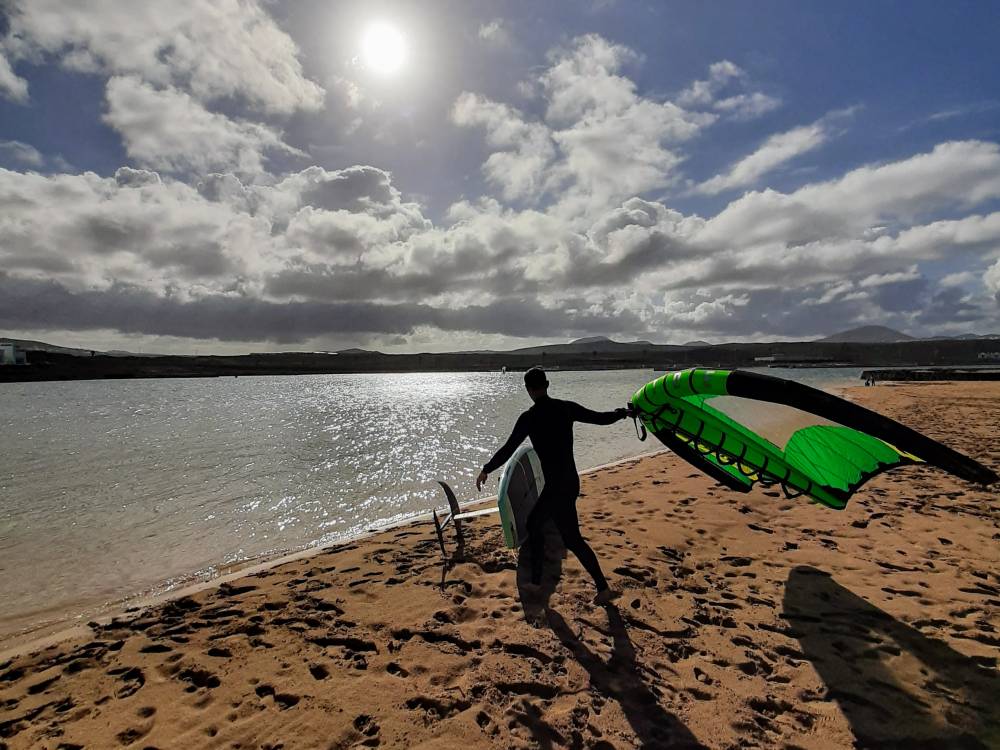
Attempt # 1 By now I can get into position quite quickly, although it is clear that there is still a lot of room for improvement. Once in position I try to push on the legs and pump, as I have seen in the videos, to raise the table but concentrated as I am on the table I do not realize that the sail touches the water and I fall.
I expect the usual walk to go upwind, but carrying the sup with the foil and the wing in one go is rather complicated. Fortunately Sergio comes to my rescue!
As I wait for my turn to come again, I watch the other students and their progress. The guy who windsurfed is undoubtedly a little ahead of us. His position is better and he manages to keep upwind enough. However, even he still can't get the board up.
Attempt # 2 When it's up to me again I try to focus on the position, unfortunately the wind is going down and except for a few gusts I feel that it cannot be strong enough. On the other hand I feel the fin working in the water and I finally manage to bleed, even if still not enough to go back to the starting point. I keep on winding up a bit.
Attempts n.xx We continue to try a little more, although Alessandro has warned us that with the foil we have and the wind so low it is almost impossible to get up. And in fact I can only get up for a short moment, but not keep my pace for long.
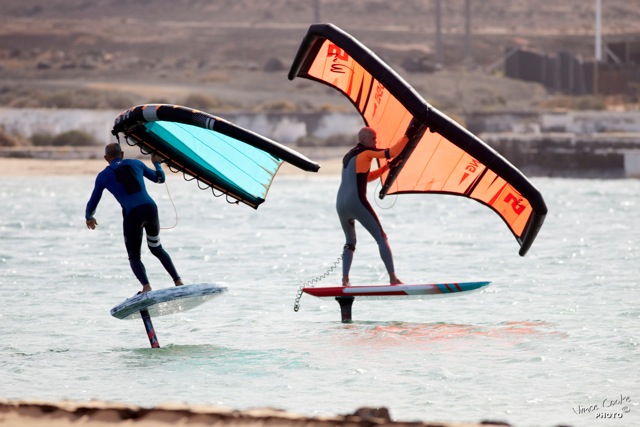
In the meantime I cross Max, a local that is an old acquaintance of ours, which literally leaves me stunned with some superstilose maneuvers and some nice leaps ... definitely frustrating!
I had forgotten the long walks on the beach with the kite in the sky before learning to wind, as well as the days spent watching the other kiters whizzing and circling in the air while for me the conditions never seemed adequate. These attempts with wingsurfing brought everything to mind.
Conclusions
Without a doubt, it's still a little early to draw conclusions, but if there are a few things I understand, they are:
1. Before going into the water it helps a lot to learn how to handle the wing on the ground.
2. If possible, do your tests with a minimum of 15 knots and less than 25 and carefully choose a spot with enough space to dribble without problems and, of course, flat water.
3. Try first with a sup board, without foil, beautiful voluminous. Bolinating with a sup board is difficult, especially at the beginning when you have not yet acquired the right sensitivity, but it is really an excellent exercise.
4. When you switch to foil use one with a very wide front wing (minimum 1800, but 2000 even better).
5. Wingsurfing is really quite simple, safe and suitable for everyone, but with some small clarifications.
That wingsurfing is easy is already a commonplace now so widespread that those who approach it the first time risk being discouraged if they fail to close some maneuvers on the first edge ... I myself was convinced that I would have wound up on the first edge, but so it was not ... and luckily, otherwise he would probably have already bored me!
Would I say that Wingsurfing is difficult? I wouldn't say that either, at least not if we compare it to kitesurfing.
Wing surfing is a sport that can be approached easily, gliding, being in the water and having fun from day 1. However, this is only a first step towards progression, considering that the possibilities are still to be explored and looking at Max I understood that we will soon see some beautiful!
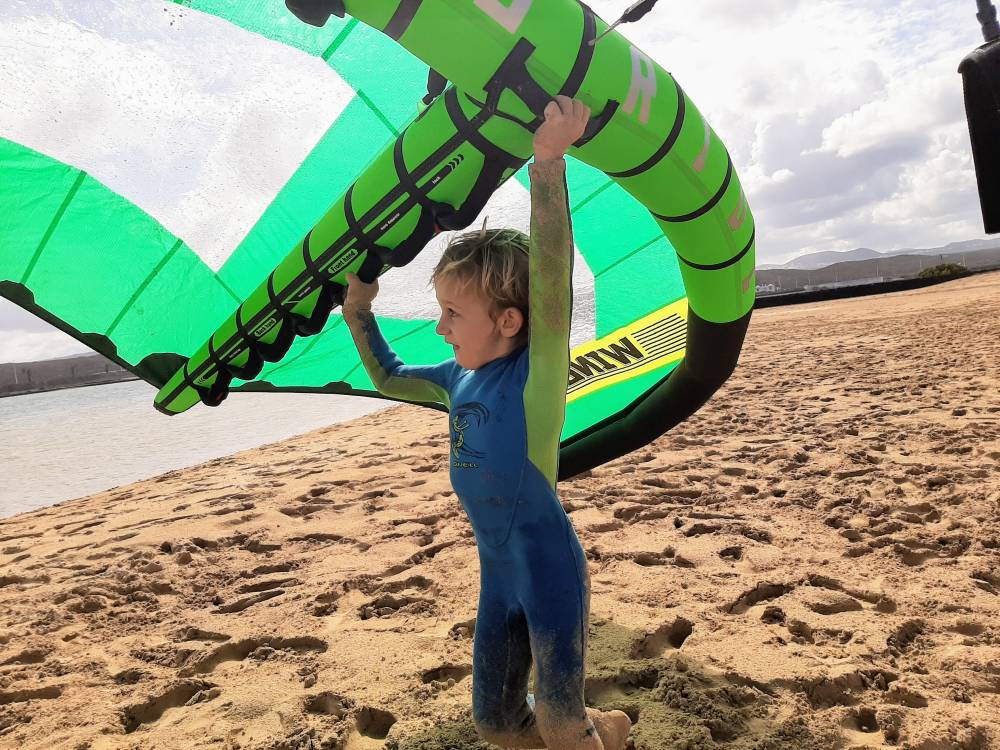
A second note I would like to do it on security.
Using the wing with a sup board is really something for everyone and that does not present any risks, provided of course that you use a little common sense regarding the choice of location and conditions. The addition of the foil makes it undoubtedly more exciting and a little more dangerous, but not as much as using the foil for example with kitesurfing. The size of the board makes it almost impossible for the foil to turn up, so falling on it is really quite a remote possibility. The problem remains to protect yourself in the event of an accidental collision in the water, therefore helmet and jacket are always essential ... in addition to a fair amount of common sense in choosing the right conditions for your tests.
And have you already tried? How did it go? Or have you not tried it yet and would you like to ask us questions or do you want to try it too? contact us!
Pubblicato il 08 febbraio 2020 | Blog > Technique: WING | SUP

